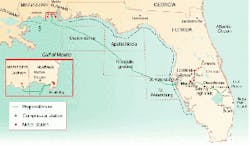Gulf of Mexico: High pressure, extra drying to keep gas flowing for Gulfstream pipeline
With the completion of the sale of Gulfstream to the Duke Energy/ Williams group, which should take place this month, the Gulfstream pipeline will get underway. Federal Energy Regulatory Commission (FERC) certification is expected in February, and plans are in place for construction to begin in June. If const-ruction proceeds as planned, the pipeline will be completed in June 2002.
Electricity consumption has increased 700% in the past 35 years in Florida, and according to nearly every reliable source, that trend is going to continue. Gary Lauderdale, Sr. Vice President and General Manager of Williams, who along with Duke Energy could be developing the Gulfstream pipeline, classifies Florida's gas market as "the best growth market in the world."
There is no question that Florida needs the gas, but a ban on drilling within 100 miles of the Florida coast precludes drilling for gas nearby.
The proposed solution is to move gas produced offshore Mississippi and Alabama to onshore facilities, then take the gas back offshore for transmission to its final destination. That plan, in fact, met with approval in Florida, but it posed significant challenges to engineers tasked with transporting the gas 440 miles across the Gulf of Mexico.
Environmental concerns
This project is singular in a number of respects, not the least of which is that it has involved over 125 environmental organizations and government agencies as it moved from concept to formal project. Agency review and permitting have been unique. Though separate applications were submitted to the FERC and to the Minerals Management Service, the organizations jointly produced a single Environmental Impact Statement.
From the outset, environmental concerns were at the forefront of project development. The live bottom areas of the Gulf, where marine growth is abundant, are of significant concern. There are millions of acres of live bottom in the Gulf, and sea grass beds cover much of the shallow shelf areas. In addition to live bottom, there are hard bottom areas where rock or hard, compacted sands can support marine growth.
These areas, too, had to be circumvented when laying out the route from Mobile Bay to Manatee County, Florida. In the end, the route ran through Tampa Bay, so that sea grass beds could be avoided.
However, routing alone was not enough to minimize environmental impact. According to Gulfstream Project Director, David Hairston, of Willbros Engineers, Inc., "The pipeline route avoids the more dense live bottom and hard bottom groupings, but damage to the bottom occurs when:
- A pipeline is trenched
- Anchors are placed, which cause anchor scars
- Cables that are connected to barges cause 'cable sweep' in sensitive areas."
Discussions with contractors allowed engineers to quantify potential damage and determine ways to minimize it. Hairston explained that "special anchor handling procedures for lay vessels and the use of dynamic positioned vessels to avoid anchor usage" figure into the environmental plan.
Dry gas system
Once an acceptable route was established, the next major question was technical. How could engineers ensure that they could meet the commitment of operating a completely dry gas system? The answer was to put the gas treatment facility on the upstream side of the compressor station to provide additional water dehydration and removal of additional gas liquids from the pipeline.
By doing this, Gulfstream could guarantee the state of Florida that even under the most onerous operating conditions, the pipeline would be liquid-free. The result of this is a buffer between the pipeline and the gas processing plants that ensures that water dropout and hydrocarbon liquid dropout do not appear in the pipeline.
Pressure regulation
The next technical concern was pressurizing the gas sufficiently to traverse 440 miles of pipe without recompression every 50-100 miles. The solution was to pressurize the gas to 2,180 psig, nearly 1,000 psig higher than other transmission systems in the United States, which operate in the 900-1,200 psig range. Hairston explains, "What makes it possible to send the gas this distance is that we're raising the pressure about two times over what is normal. This does two things. It greatly improves our efficiency in moving the gas across the Gulf, and it allows the pipeline to act as a large storage facility to take variations in demand in the Florida market.
"Basically, we have a large pipeline that we will pack to higher pressures to meet the swing in demand of the Florida market."
When the gas comes onshore, pressure-regulating valves will take the high-pressure gas and reduce it to a maximum allowable pressure of 1,480 psig. Hairston explains that "although this kind of pressure regulating happens when a transmission line feeds into a local distribution company, it is unusual to step down pressure within a single transmission line. That is unique to this project."
The pipeline employs construction methodologies that Hairston classifies as "proven approaches with some unique applications." Innovation lies not in reinventing the wheel, but in using reliable technology in new ways.




